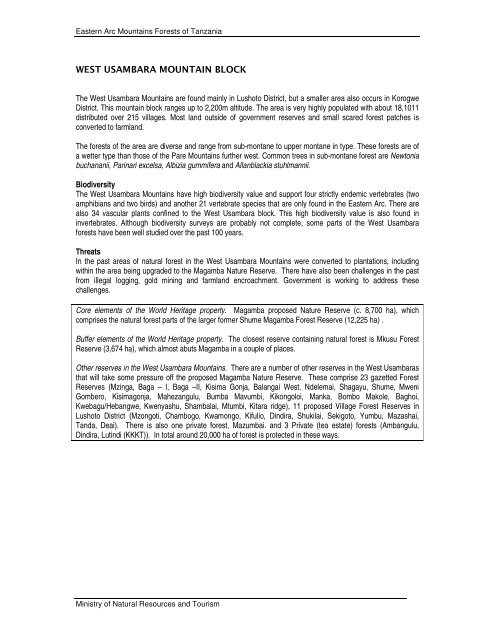eastern arc mountains forests of tanzania - Campaign for the ...
eastern arc mountains forests of tanzania - Campaign for the ...
eastern arc mountains forests of tanzania - Campaign for the ...
You also want an ePaper? Increase the reach of your titles
YUMPU automatically turns print PDFs into web optimized ePapers that Google loves.
Eastern Arc Mountains Forests <strong>of</strong> Tanzania<br />
WEST USAMBARA MOUNTAIN BLOCK<br />
The West Usambara Mountains are found mainly in Lushoto District, but a smaller area also occurs in Korogwe<br />
District. This mountain block ranges up to 2,200m altitude. The area is very highly populated with about 18,1011<br />
distributed over 215 villages. Most land outside <strong>of</strong> government reserves and small scared <strong>for</strong>est patches is<br />
converted to farmland.<br />
The <strong><strong>for</strong>ests</strong> <strong>of</strong> <strong>the</strong> area are diverse and range from sub-montane to upper montane in type. These <strong><strong>for</strong>ests</strong> are <strong>of</strong><br />
a wetter type than those <strong>of</strong> <strong>the</strong> Pare Mountains fur<strong>the</strong>r west. Common trees in sub-montane <strong>for</strong>est are Newtonia<br />
buchananii, Parinari excelsa, Albizia gummifera and Allanblackia stuhlmannii.<br />
Biodiversity<br />
The West Usambara Mountains have high biodiversity value and support four strictly endemic vertebrates (two<br />
amphibians and two birds) and ano<strong>the</strong>r 21 vertebrate species that are only found in <strong>the</strong> Eastern Arc. There are<br />
also 34 vascular plants confined to <strong>the</strong> West Usambara block. This high biodiversity value is also found in<br />
invertebrates. Although biodiversity surveys are probably not complete, some parts <strong>of</strong> <strong>the</strong> West Usambara<br />
<strong><strong>for</strong>ests</strong> have been well studied over <strong>the</strong> past 100 years.<br />
Threats<br />
In <strong>the</strong> past areas <strong>of</strong> natural <strong>for</strong>est in <strong>the</strong> West Usambara Mountains were converted to plantations, including<br />
within <strong>the</strong> area being upgraded to <strong>the</strong> Magamba Nature Reserve. There have also been challenges in <strong>the</strong> past<br />
from illegal logging, gold mining and farmland encroachment. Government is working to address <strong>the</strong>se<br />
challenges.<br />
Core elements <strong>of</strong> <strong>the</strong> World Heritage property. Magamba proposed Nature Reserve (c. 8,700 ha), which<br />
comprises <strong>the</strong> natural <strong>for</strong>est parts <strong>of</strong> <strong>the</strong> larger <strong>for</strong>mer Shume Magamba Forest Reserve (12,225 ha) .<br />
Buffer elements <strong>of</strong> <strong>the</strong> World Heritage property. The closest reserve containing natural <strong>for</strong>est is Mkusu Forest<br />
Reserve (3,674 ha), which almost abuts Magamba in a couple <strong>of</strong> places.<br />
O<strong>the</strong>r reserves in <strong>the</strong> West Usambara Mountains. There are a number <strong>of</strong> o<strong>the</strong>r reserves in <strong>the</strong> West Usambaras<br />
that will take some pressure <strong>of</strong>f <strong>the</strong> proposed Magamba Nature Reserve. These comprise 23 gazetted Forest<br />
Reserves (Mzinga, Baga – I, Baga –II, Kisima Gonja, Balangai West, Ndelemai, Shagayu, Shume, Mweni<br />
Gombero, Kisimagonja, Mahezangulu, Bumba Mavumbi, Kikongoloi, Manka, Bombo Makole, Baghoi,<br />
Kwebagu/Hebangwe, Kwenyashu, Shambalai, Mtumbi, Kitara ridge), 11 proposed Village Forest Reserves in<br />
Lushoto District (Mzongoti, Chambogo, Kwamongo, Kifulio, Dindira, Shukilai, Sekigoto, Yumbu, Mazashai,<br />
Tanda, Deai). There is also one private <strong>for</strong>est, Mazumbai. and 3 Private (tea estate) <strong><strong>for</strong>ests</strong> (Ambangulu,<br />
Dindira, Lutindi (KKKT)). In total around 20,000 ha <strong>of</strong> <strong>for</strong>est is protected in <strong>the</strong>se ways.<br />
Ministry <strong>of</strong> Natural Resources and Tourism


